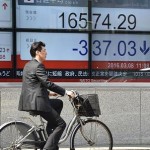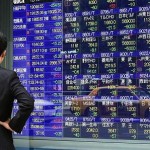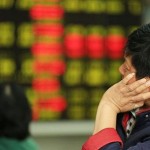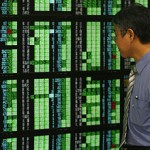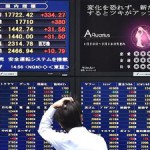Most Asia markets advance, with Nikkei rising as yen slips
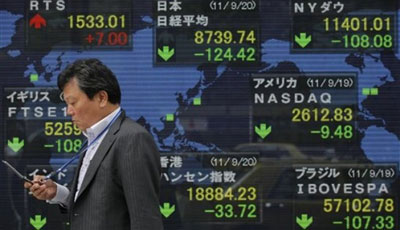
Most major Asia markets ended higher Tuesday, shrugging off after a lower finish in U.S. equities overnight ahead of earnings season.
Australia’s ASX 200 added 44.06 points, or 0.89 percent, to 4,975.60, boosted by a 1.73 percent gain in the heavily-weighted financials subindex. The country’s so-called Big Four banks – ANZ,Commonwealth Bank of Australia, Westpac and NAB – traded up between 1.3 and 2.49 percent. In recent weeks, the banking stocks had come under pressure over concerns of bad debts due to their exposure to the energy and resources sectors.
Japan’s Nikkei 225 closed up 177.66 points, or 1.13 percent, at 15,928.79, buoyed by the yen’s retreat back to the 108 handle against the dollar. Across the Korean Strait, the Kospi advanced 10.95 points, or 0.56 percent, to 1,981.32. Hong Kong’s Hang Seng index was up 0.29 percent in late afternoon trade.
Chinese mainland markets declined, with the Shanghai compositeclosing down 9.42 points, or 0.31 percent, at 3,024.52, and theShenzhen composite losing 16.87 points, or 0.86 percent, to 1,935.60.
In the currency market, the dollar weakened against a basket of currencies, with the dollar index dropping to 93.95 overnight. As of 3:25 p.m. HK/SIN time on Tuesday, the index retreated further to 93.86.
Kathy Lien, managing director of foreign exchange strategy at BK Asset Management, wrote in a note that investors are reluctant to own dollars. “They are still skeptical about a 2016 rate hike even though each and every Federal Reserve official who has spoken, dove and hawks included, see tightening in 2016,” she said.
The Japanese yen retreated to the 108 handle against the dollar, with the dollar/yen pair traded at 108.20 Tuesday late afternoon local time, after finishing at 107.93 in the previous session.
The yen’s relative weakness on Tuesday buoyed major Japanese export stocks, with shares of Toyota adding 3.92 percent, Nissan gaining 3.28 percent and Honda up by 3.79 percent. A weaker yen is a positive for Japanese exporters as it increases their overseas profits when converted into local currency.
The Australian dollar traded at $0.7637 in the evening local time, after finishing at $0.7594 in the previous session. Analysts attributed the uptick in the Aussie to advances in commodity prices and improvement in risk appetite.
Lien added the deluge of Chinese economic data due this week will also be a focus for the Aussie.
The Chinese yuan was weaker against the dollar, with the dollar/yuanpair trading at 6.4643. Before market open, the People’s Bank of Chinafixed the yuan mid-point at 6.4616, compared with Monday’s fix at 6.4649. China’s central bank lets the yuan spot rate rise or fall a maximum of 2 percent against the dollar relative to the official fixing rate.
In Asian hours, oil prices wavered between positive and negative territory. As of 3:28 p.m. HK/SIN time, U.S. crude futures were up 0.22 percent at $40.45 a barrel, while global benchmark Brent added 0.28 percent to $42.95.
Overnight, oil prices advanced ahead of the April 17 meeting of oil producers in Doha, Qatar, aimed at freezing current output levels. Brent futures added 2.12 percent and U.S. futures tacked on 1.6 percent.
Energy plays in Asia were mixed, with Santos closing down 0.51 percent, Woodside Petroleum ending flat and Japan’s Inpex adding 2.24 percent. Mainland Chinese oil plays were mixed, with Sinopecshedding 0.52 percent and PetroChina closing flat.
Metal plays in the region were mixed. Mining stocks in Australia were mostly up, with major miners Rio Tinto, BHP Billiton and Fortescueadvancing between 2.11 and 3.86 percent. Chinese metal plays were mixed, with Baoshan Steel adding 0.85 percent and Aluminium Corpdown 0.87 percent.
Overnight, on the London Metal Exchange, base metals closed mixed, with three month aluminum down 0.8 percent, zinc up 0.3 percent and copper up 0.3 percent, according to Reuters. During Asian hours, as of 3:30 p.m. HK/SIN time, the base metal prices were also mixed.
Major U.S. indexes closed lower, with the Dow Jones industrial averagedown 0.12 percent, the S&P 500 off by 0.27 percent and the Nasdaq composite declining by 0.36 percent.
Rodrigo Catril, a currency strategist at the National Australia Bank, wrote in a morning note that the struggle for direction in U.S. equity markets reflected “a lack of conviction ahead of the ‘true’ start to the quarter earnings reporting season.”
Source: CNBC









